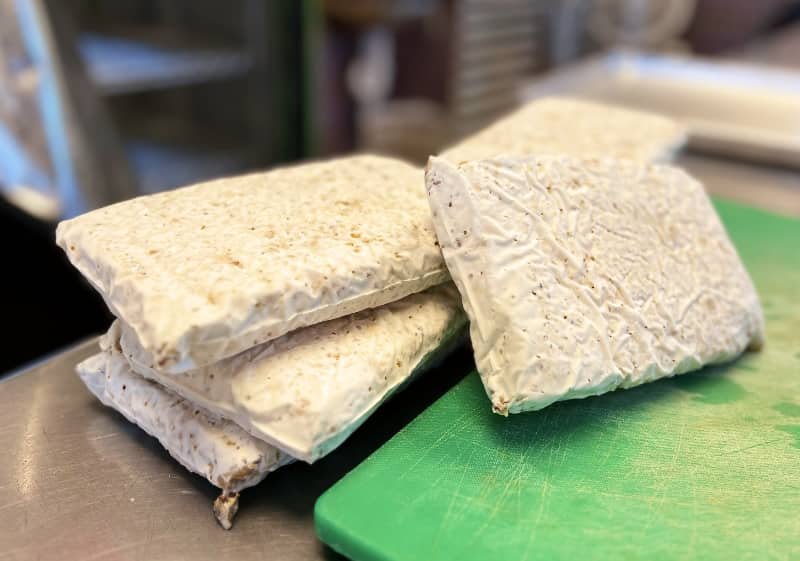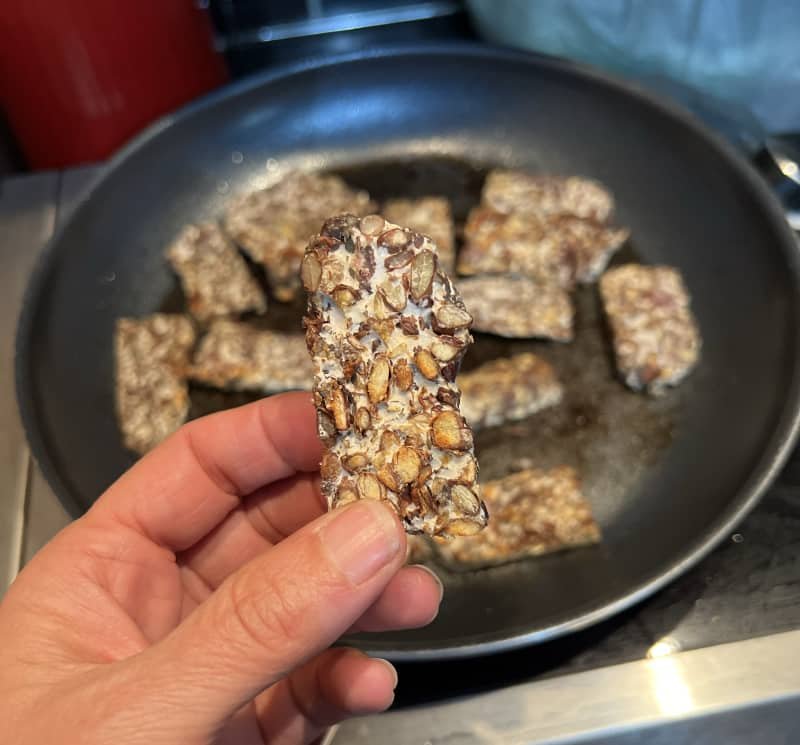
Fresh, unpasteurized tempeh is a little bit different from the shrink-wrapped mass-produced tempeh you might be familiar with. Below our fresh tempeh FAQ has the answers to common questions people have about our tempeh.
WHAT DOES THE BEST BY DATE MEAN?
We set the best by date on our fresh tempeh as 7 days past the birth date. Our frozen tempeh has a best by date 6 months past the birth date.
Best by date is not the same as an expiration date. Your tempeh can still be quite good past that date. Scroll down to see how to store and then how to know when tempeh is bad. Fresh tempeh will start to dry out long before it goes bad.
When we supply our tempeh frozen, the date displayed is a "best by" date as long as the tempeh is kept frozen.
HOW LONG CAN I STORE FRESH TEMPEH?
You can age fresh tempeh for up to 10 days in the refrigerator. The aged tempeh will have a stronger flavor. And because the packaging is designed to let the tempeh breathe, it may dry out a bit around the corners. If it does this, use it in something saucy!
Do not stack the tempeh in the refrigerator. Because the fungus is still alive, it will continue to culture very slowly in the refrigerator. But if you stack it, that process speeds up. If it feels warm, that’s because it is growing!
If you want to maintain the flavor of the freshest tempeh but need to store it longer, freeze it in a sealed container. Freezing it will keep the culture from growing but does not kill it! Thaw in the refrigerator for a couple of hours and use as you would fresh tempeh.
WHAT IS THE PROTEIN CONTENT OF TEMPEH?
We get asked about the nutritional information for our tempeh all the time. While not as accurate as laboratory analysis, we have plugged the ingredients into a nutrition fact calculator so you can get an idea of how our tempeh fits in your diet. You'll find that information on our varieties page below each tempeh. If you click through the red link at the bottom of each label, you can also see details on micronutrients and more.
WHAT IS THE WHITE FUZZY STUFF ON THE TEMPEH?

The soft white mat covering the tempeh is the mycelium of the Rhizophus mold used to culture it. The mold feeds on the substrate (the beans, grains, nuts and seeds) and grows around them. In addition to holding the substrates into a cake, the mycelium also makes beans easier to digest.
WHAT ARE THE BLACK SPOTS ON MY TEMPEH?

Black spots are the fruiting bodies of the mycelium like a mushroom. It just means the tempeh has cultured further, not that it’s bad. You can still cook it and eat it.
HOW CAN I TELL IF THE TEMPEH HAS GONE BAD?
Fresh tempeh should have a white exterior showing its still alive. In time it will start to develop black spots which is still okay. Good fresh tempeh should be firm with a fresh mushroomy aroma.
Signs your tempeh might be past its prime:
- Unpleasant odor
- Mushy texture
- Pink or other colors than white or black
- Slimy or sticky texture
WHAT ARE THE BENEFITS OF FRESH TEMPEH?
Since it is unpasteurized, tempeh still contains live probiotics. However, we do recommend that you cook our tempeh which will kill the probiotics. But in addition, the fiber in tempeh is a wonderful prebiotic which makes tempeh wonderful for gut health.
In addition to that, the flavor and texture of unpasteurized tempeh is so much better than pasteurized. In fact, many people that don’t like pasteurized tempeh love our fresh or fresh-frozen tempeh.
HOW DO I COOK FRESH TEMPEH?

Our favorite way to eat fresh tempeh is very simple: slice it and pan fry it with a tiny bit of oil and a sprinkle of salt. It’s wonderful on a salad or buddha bowl this way.
If you want more of a flavor punch, brush the tempeh with your favorite marinade and bake it on a baking sheet until lightly browned.
Another option, pan fry as above, then once it’s browned, add your favorite BBQ sauce, stir until coated, and heat for another minute or so.
Need some more ideas? Check out our growing list of quick and easy recipes for your tempeh.
CAN YOU EAT TEMPEH RAW?
Our tempeh contains living mycelium whether you buy it fresh or frozen but we don't recommend that you eat the tempeh raw. While we take every precaution to make sure only beneficial bacteria are growing in our tempeh, the best way to avoid illness is to cook your tempeh. That said, we do have customers that eat our tempeh raw.
IS LUV TEMPEH ORGANIC?
All of the ingredients in our tempeh varieties are organic.
IS LUV TEMPEH GLUTEN-FREE?
Most of our varieties are made of gluten-free ingredients but we are not a certified gluten-free kitchen. We do have some that include organic oats that are not certified gluten-free. If we produce any other tempehs that have gluten ingredients in the future, that information will be on the label.
WHERE CAN YOU BUY UNPASTEURIZED OR FRESH TEMPEH?
We have a growing list on our site of places where you can buy our unpasteurized tempeh fresh or frozen. You can also try an internet search for "fresh tempeh YOUR CITY." There are small tempeh manufacturers in surprising places!
